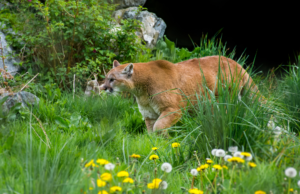4 Facts You Probably Didn’t Know About the Eastern cougar: Species at Risk Series
Author: Stacy Corneau
Many animals and plants call the forests, wetlands, rivers, and other natural spaces across Ottawa Valley home. But some are facing challenges, from development to hunting and even extractive activities.
This new monthly series spotlights species at risk across Ontario and Quebec, what makes them unique, and what can be done to protect them and their habitats.
Missed the first one? We dove into 5 fascinating facts about the Algonquin wolf.
Quick recap: what is a species at risk?
Species at risk are animals and plants in danger of disappearing from Canada’s wild unless we act quickly.
The provincial and federal governments use five terms to categorize at risk species in Canada depending on their threat status: special concern, threatened, endangered, extirpated, and extinct. The first blog in the series breaks down each one in detail.
Clear-cut logging, mining, oil, and road or housing development are only a few of the human dangers these species face every day.
Why are we talking about species at risk?
We fight to protect Ottawa Valley’s public lands and waters, promoting conservation and management of our rich natural resources.
We are the voice for wilderness in Eastern Ontario and Western Quebec, fostering thriving wild ecosystems in parks, wilderness, and similar natural areas to preserve full diversity of habitats and their species.
At risk animals and plants need a home and our communities need healthy biodiversity.
4 facts about the Eastern cougar
This month, we’re highlighting the Eastern cougar.
Otherwise known as Puma concolor couguar, this big cat falls under a unique category: data deficient. COSEWIC declared the Eastern cougar endangered in 1978 but a re-examination in 1998 found there wasn’t enough data to thoroughly evaluate its status. This species has been declared extinct in the United States.
What do they look like?
Eastern cougars have short tan to reddish or grayish-brown fur with a white chest and stomach. Their trademark black tipped tails and markings on their ears and muzzles make them unique from other big cats.
Male cougars grow to nearly seven feet long and can weigh up to 220 pounds, with females being slightly smaller.

How do they hunt?
Eastern cougars hunt at night. Couguars rarely rely on chasing their prey, instead locating prey by scent or sound before carefully and silently slinking forward until they can pounce.
Eastern cougars eat deer, beavers, porcupines, and other small mammals.
Where do they live?
Eastern cougars were once found across North America following the range of their main prey, the white-tailed deer. With their population now dwindling, Eastern cougars are primarily found in Ontario, Quebec, New Brunswick, and Nova Scotia.

What threatens their survival?
Eastern cougars rely on large, undisturbed forests with enough food and water, such as from a lake or river, for safe habitat. Increased human interference pushes them into smaller and smaller living areas, unsuitable for survival.
Part of this challenge is due to the explosion of human development in natural areas. Logging, human settlement, and mining are the main activities contributing to the lower population.
The white-tailed deer has also migrated more towards human-dwelling areas for two main reasons: more food, fewer predators. The Eastern cougar tends to avoid populated areas and with their food supply changing course, they have less deer to hunt.
Their food supply is also changing its course. The white-tailed deer has begun migrating towards human-dwelling areas with more food and fewer predators, resulting in the Eastern cougar having less deer to fulfil their diet.
What about the Western cougar?
It’s important to remember the Western cougar – also referred to as a mountain lion – is listed as endangered. They can be found in Western Canada, roaming across Southwestern Alberta and British Columbia. Their coat is plain and usually a tan, reddish-brown, or grayish-brown colour.
3 ways you can help protect the Eastern cougar
Reduce, reuse, recycle! When we use less paper or other forest products, there’s less pressure to log the Eastern cougar’s remaining habitat. Consider recycling all paper and cardboard products, opting to buy recycled products when possible, and swapping out daily paper products for reusable alternatives.
Stay up to date on local development plans that could negatively impact cougar habitat. You can stay in the loop by following your MP’s work or signing up for our newsletter.
If you learn of logging or development activities that may harm the Eastern cougar’s habitat, you can also contact your MP, MPP, and local councillor to voice your concern.
Up next
Next month, we’ll be diving into the beautiful ram’s-head lady’s slipper orchid, which you can find in Gatineau Park.
